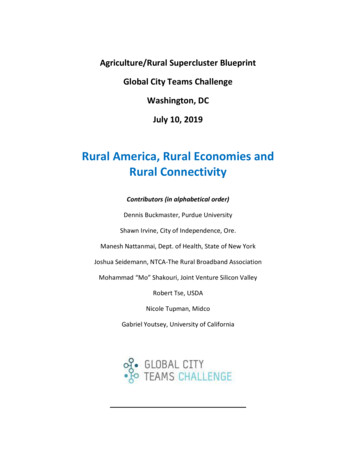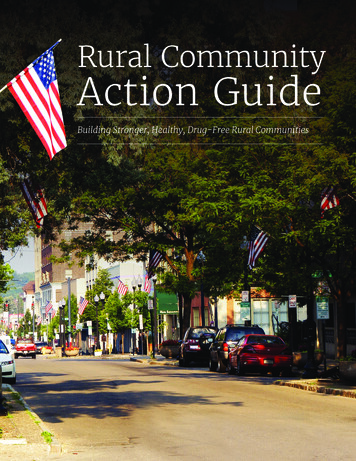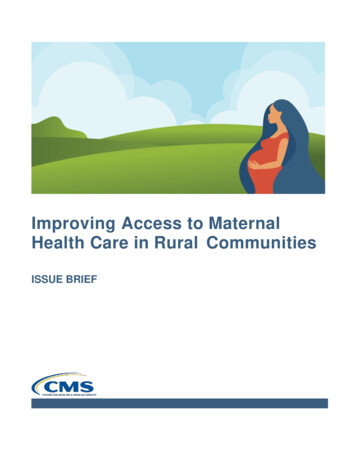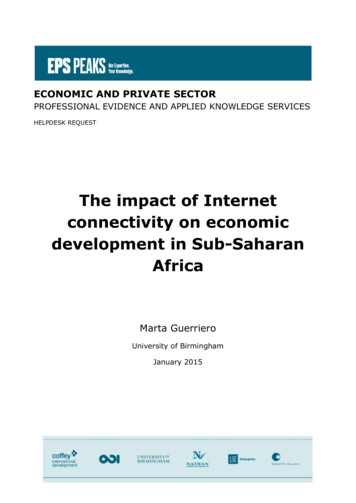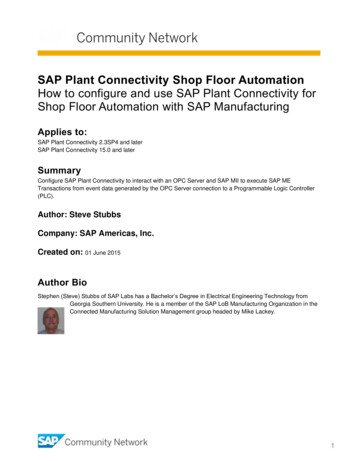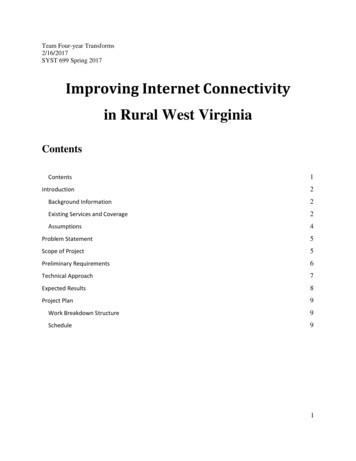
Transcription
Team Four-year Transforms2/16/2017SYST 699 Spring 2017Improving Internet Connectivityin Rural West VirginiaContentsContents1Introduction2Background Information2Existing Services and Coverage2Assumptions4Problem Statement5Scope of Project5Preliminary Requirements6Technical Approach7Expected Results8Project Plan9Work Breakdown Structure9Schedule91
IntroductionIn this digital age, high speed internet access is necessary for economic development, research purposes,and much more. As part of a larger endeavor to enhance the infrastructure and quality of life in WestVirginia, our group has been asked to address broadband internet connectivity in particular.Many parts of rural West Virginia lack access to a high speed internet connection. Students, jobapplicants, business owners, and many others in West Virginia will incur economic losses due to theirinability to capitalize on the advantages that the internet offers. Providing broadband internet access couldimprove school quality, provide many economic opportunities to citizens and business owners, andimprove the general quality of life for the citizens of West Virginia. Not only will it benefit the citizens, itwill also become a new market for the service providers.Background InformationThe project is focused on the three southernmost counties in West Virginia: McDowell, Wyoming, andMercer. These three counties are mountainous, relatively poor, and not densely populated; their internetinfrastructure is sparse.Existing Services and CoverageWhile land-line telephone service is ubiquitous in the project area, broadband, primarily via the telecomcompany Shentel, is only available in the larger towns, and along the routes connecting them, through amixture of fiber-optic and coaxial copper cable.Wireless connectivity is more widespread, but even there, coverage can be spotty; terrain can masksignificant areas, and the cell tower network is not very dense in that part of the state (see figure 1). BothVerizon and AT&T (figures 2 and 3), among several other networks, claim to cover all or part of the area,but their claimed coverage area is often overly optimistic.2
Figure 1 - Cell Tower locations from www.deadcellzones.comFigure 2 - Verizon Cell Tower Data* Coverage*meaning any form of Data(2G,3G,4G )3
Figure 3 - AT&T 4G CoverageAssumptionsFor purposes of this project, we assume that each household in the project area has, at a minimum, atelephone line. Whether this phone line can practically be used for DSL is a separate question, of course;we will assume that the wires themselves are adequate, if the necessary network infrastructure is in place.Some broadband internet service is already present in parts of the project area. We assume that theinternet service providers have an acceptable level of cyber security built into their service. We alsoassume that the existing ISPs’ service uptime is on the order of 99.5%.4
Problem StatementThe goal of this project is to understand the options, and the tradeoffs between the options, for providingbroadband internet access to a key area in southern West Virginia.The desired result of this project is a well-characterized and analyzed trade-off space, covering capitalinvestment, internet connection speed, expected availability, return on investment, security, and otherrelated factors.Scope of ProjectIn West Virginia, there are several counties that are ideally representative of the internet connection issuesthat this project is aiming to address. Those counties are Mercer, McDowell, and Wyoming counties,which are all adjacent to each other at the southern border of West Virginia. While McDowell andWyoming has significantly more wired infrastructure than Mercer counties, they all share the commonissue of rural areas being disconnected from the world wide web.The primary scope of this project is to analyze the existing conditions and available services in the targetregion, and generate alternative solutions for providing internet access to the underserved rural areas ofthe target counties. With this data, the citizens of the region can view the short-term or long-term internetservice options to help them decide if they would like to pursue one. From the Internet Service Providerside, they can use the data to determine if they can economically expand their services into theunderserved areas. This project will consider the upper time limit as 10 years from the start of this project.To provide a comprehensive analysis and solution to the problem, this project will be comprised ofseveral components that accurately define the various aspects that project aims to address. The overallproject will consist of the Stakeholder analysis (SA), Alternatives Solutions Analysis (ASA), and theEconomic Analysis. The Stakeholder Analysis (SA) will provide an initial look of the region as a wholein regards to its population, average income, population density, terrain, and locational issues. It will alsofeature a survey of users to obtain the current condition of their access and its quality if applicable, alongwith information from the Internet Service Provider(s). The ASA will contain data for eachtechnology/service provider available for the three counties which will include bandwidth,upload/download speeds, and monthly cost. The EA will address the financial and economic issues withthe solutions defined in the ASA.Subsequent effects of providing high speed internet to those who have been deprived of the access arenumerous. At the very least, it provides internet applications and services that were previously notavailable on slow or non existent internet service. This allows students and teachers to access a plethoraof material online. For those seeking employment, this provides access to online applications andeducational materials for training. For businesses, this may open a new world of opportunity as brick andmortar stores can move to conduct business online as well.5
Preliminary RequirementsUID Functional Requirement DescriptionImplemented In1General System Requirements1.1System shall address the internet conditions for Mercer, Wyoming, andGIS ModelMcDowell Counties of West Virginia. The named counties will be referred toas the "target regions" for this project.1.2System shall list the existing Internet Service Providers in the target regions.AlternativesSolutions Analysis1.3System shall provide the limitations of bandwidth, upload speed, anddownload speed of each Internet Service Provider available.AlternativesSolutions Analysis1.4System shall provide at least one internet service solution for all householdsin the target region.AlternativesSolutions Analysis2Analytics Requirements2.1System shall create a matrix correlating the available services againstmonthly cost and download speeds.EconomicsAnalysis2.2System shall use a quantitative metric to compare different internet servicealternatives.EconomicsAnalysis3Technical Requirements3.1System shall provide a Geographic Information System (GIS) modeldisplaying the target regions with current existing wired infrastructure.GIS Model3.2System shall provide a Geographic Information System (GIS) modeldisplaying the target regions with a proposed expansion.GIS Model4System Security Requirements4.1System shall provide Broadband options that provides a direct connection tothe service provider.AlternativesSolutions Analysis6
Technical ApproachThe IIC project will proceed along two tracks in parallel: one track will be a quantitative analysis usinggeographic information system (GIS) software; the other will be more qualitative research on the systemsthat are available, or are expected to be available soon, and their capabilities.For the GIS track, we first will collect data on current broadband availability, both wired and wireless, inthe area of interest. For wired, this will largely consist of current fiber and coaxial lines; for wireless, thiswill largely consist of existing cell towers and their viewsheds. Additionally, if time permits, we mayattempt a viewshed/orbit analysis for satellite internet availability.Next, we will collect GIS data on population distribution in these three counties. Using that data, alongwith the current availability maps, we should be able to identify areas of significant population wherebroadband is not available. Within the set of these areas, we can then identify which areas can be coveredwith DSL lines, which can be covered with new fiber/coaxial lines, which can be covered with newcellular towers, and so on, taking into account the results of the Non-GIS track research.In the Non-GIS track, we will research the various projects currently being worked on to provide globalwireless broadband coverage — “sky-fi”, as it’s sometimes called; how likely they are to succeed, andwhen they might be available. Related to this, we will also try to predict medium-term changes in themeaning of “broadband”, and identify which approaches might become obsolete soon, or might becomemore available.Additionally, we will try to predict demographic changes (such as urbanization or depopulation) whichmay change the areas that need service.Finally, we will analyze the trade-off space between capital investment, internet connection speed,expected availability, return on investment, security, and so on. To understand this trade-off space is themain goal of the project.7
Expected ResultsThe expected results from this project will be in two parts. The first part will provide a current status ofthe existing broadband conditions and available services in the three target counties. Based on the analysisof the current broadband condition in the target area, we will generate alternative solutions for improvingconnectivity in the target area. The recommended solution will consist of short-term and long-termservice options. The user will obtain additional broadband options, and the internet provider will have atradeoff analysis for whether to expand their services and what are the costs or ROI.To provide accurate technical comparisons and analyses of the technology available, there will be anAlternative Solutions Analysis (ASA). As mentioned earlier, the ASA will contain technical data for eachtechnology/service provider available. Along with the current technical data, it will include data forinfrastructure expansion if applicable, which includes the service provider’s costs to expand (permile/consumer), as well as any costs that will be paid by the end user.The second part of the project will provide future predictions, either in demographic changes suchincrease or decrease in population size which might impact the area needed for services. Also anotherfuture prediction will be technology changes that might include new ways of providing broadband such“sky-fi” internet.The alternative solutions will be analyzed to generate matrices that display the short/long term costs andbenefits. These matrices will be a part of the Economic Analysis (EA). This will provide an economiccomparison for the consumer and service providers to see what the best course of action will be for therespective parties. The matrices will contain the service types, upload/download speeds, bandwidth,monthly costs, availability timeline, expansion costs, and expansion customer population. By providingthe solutions in this format, the stakeholder should be able to obtain a more comprehensive view of theiroptions available in the present time as well as any in the near future.8
Project PlanWork Breakdown StructureSchedule9
company Shentel, is only available in the larger towns, and along the routes connecting them, through a . Whether this phone line can practically be used for DSL is a separate question, of course; . Some broadband internet service is already present in parts of the project area. We assume that the internet service providers have an .
